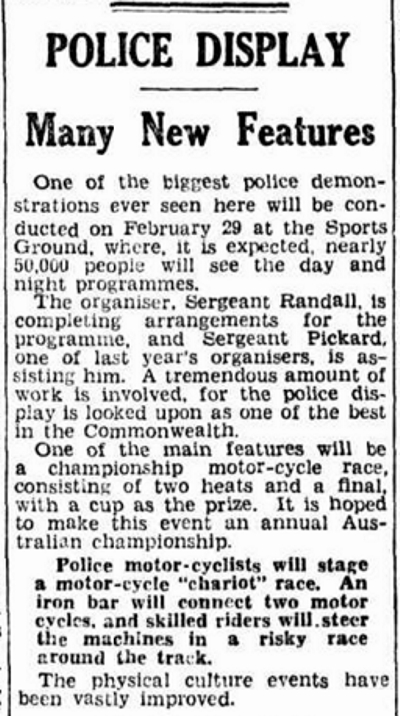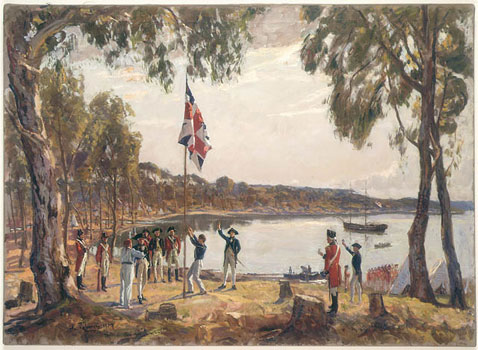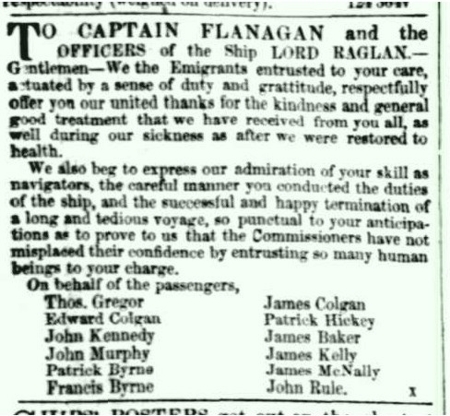A Thankyou to the Captain
As an avid Trovite, I love reading the old newspapers (as so many of us do). And yet, I am still amazed at the very cool stuff you can find in the old newspapers.
Take for instance one of my recent finds. A friend asked me to see what I could find on the “Lord Raglan” 1854 voyage to South Australia.
So after some general Googling to find out the basic details (the ship left Plymouth, Devon 16 July 1854, and arrived in Port Adelaide, South Australia on 23 October 1854), I found a copy of the original passenger list on the State Library of South Australia website. I also found references to it on the Passengers in History site, and The Ships List.
Anyway so then I headed off to Trove , and I came up with a thankyou message that the passengers had written to the Captain of the Lord Raglan ship, and they put it publicly in the the newspaper. How cool is that?
It’s great to know that Captain Flanagan and his crew looked after their passengers on the long voyage to a new life.
Another newspaper entry I found relating to the Lord Raglan, quotes the following …
The fine new ship Lord Raglan, 923 tons register, Captain Flanagan, for Adelaide, and the Appoline, of 500 tons, for Melbourne, having embarked their respective complements of emigrants from the Government dept, at Plymouth, sailed on Sunday. The Lord Raglan belongs to Messrs. W. Nicholson and Sons, of Sunderland, and has been fitted up on a most excellent plan, the result of the experience of Captain Lean, R.N., the Government emigration officer in London. Among other advantages, one-third of each bed can be turned up from the sides of the ship, so as to admit of a free passage two feet wide, all round her, and thus secure an effectual means of cleansing and ventilating the vessel every day. Her emigrants, numbering 369 souls, were under the charge of Surgeon Superintendent W. Brett.
This was from the South Australian Register, 21 October 1854, pg. 2.
Note: Trovite = a person who loves hanging out on the Trove website.
The “Fitzjames”, South Australia’s Floating Prison
A largely unknown piece of South Australia’s history is the fact that there was a prison ship (or hulk) anchored just off of Port Adelaide at Largs Bay. While we’ve heard of them in the UK, who knew that Australia had them too?
In 1876, the ‘Fitzjames’ a ship of 1,200 tons, was purchased by the South Australian Government from Mr Donaldson in Melbourne, and cost them £2,800. It was bought with the intention to use it as a quarantine ship. There’s more about this in the Evening Journal, 15 April 1876 …
“She will be moored near the North Arm, and will be used for patients while the cottage on Torrens Island will be fitted up and set apart for the convalescents. In view of the large influx of population to the colony it is important to have ample quarantine accommodation and the arrangements are now in progress will secure this without the delay which would be caused by waiting for the erection of suitable buildings.”
However by 1880 and through until 1891, the ‘Fitzjames’ served as a “Reformatory” for over 100 young boys aged from 8 through to 16.
From the Evening Journal dated 11 June 1879 …
“… if the hulk Fitzjames were not required for quarantine purposes after the buildings on Torrens Island were completed the Government would consider the advisability of converting her into a training-ship for Reformatory boys”
The first boys to call the Fitzjames home, were ones transferred from the Boys’ Reformatory at Magill in March 1880. Some had committed serious crimes, while others were guilty of petty theft, or simply deemed uncontrollable.
The inspection reports which you’ll find in the newspapers, generally give a fairly favourable report, as well as giving an idea of what the boys’ day was like. So while it’s been called a ‘prison ship’ or ‘prison hulk’, the descriptions doesn’t exactly make it sound prison-like, so I’m thinking ‘reformatory hulk’ would be a more accurate term.
Anyway here’s a snippet from the The Express and Telepgraph newspaper, dated 4 February 1887 written by the Inspector-General of Schools, Mr L.W. Stanton when he visited. Click on the link above for the full report.
“I visited the hulk Fitzjames on the 21st instant, and remained from 10.30 till 2.50. My visit was quite unexpected, and I found a majority of the boys at school and under perfect control. Those absent were engaged at work in the tailor’s and shoemaker’s shops for the morning; they attended school in the afternoon. I was informed they were all over 13 years of age, and that they received instructions from the teacher on three afternoons per week. Those under 13 attended full time. There were present in the morning 35, and in the afternoon 61, The furniture and apparatus were scrupulously clean. There was a satisfactory supply of reading books, copy books, exercise books, slates, and minor requirements, I noticed no maps, there being no place to hang any. … I found that the tuition was carried out on the lines of the standard for our public and provisional schools, and that the master had an ‘intelligent grasp of the work there laid down. … I was on the whole favorably impressed with Mr. Schrader’s work, and that I am satisfied of his fitness for his post, his industry, and his conscientious discharge of his duty. He appeared to me to control the boys with a proper degree of mildness combined with firmness, and they on their side seemed respectful, orderly, intelligent, and happy.”
However not all was great, as this report in Evening Journal from 15 November 1884 tells us …
The Commission took evidence with regard to the safety of the hulk Fitzjames, now lying at Largs Bay in deep water with sixty-four boys on board. The report read as follows:—” I have surveyed this vessel. I find the caulking below the copper very bad, in several places the oakum is completely decayed, being so bad that a rule can be pushed through from the back of the seams to the copper, and difficult to keep the ship afloat. I examined a leak on the starboard side in the lower hold, which was caused by a butt being open between two timbers. This has been temporarily stopped by wedging from inside. Through wedging one of the planks has been started from the timber nearly an inch, there by endangering the safety of the ship, as in heavy weather she must make a quantity of water. The top sides are much decayed, and planking under the copper must be bad, as in several places the nails have no hold on the planks to retain the sheets of copper from dropping off.
And the conditions continue to deteriorate, as the report from 30 June 1888 suggests …
The condition of the hulk was now worse than it was previous to the temporary repairs she underwent some time ago, and at the time he was writing there was over 3 feet of water in the hold, although the lads have been pumping morning and evening for over four hours each time, and this, considering their age and stamina, was far too great a strain on their constitutions, so he respectfully solicited the board’s interest and advice as to the immediate renovation of the vessel.
…as the timber for the vessel was cut 50 years ago she must be in a state of deterioration … She ought to be condemned …
By August 1891 they had given up on the vessel, and she was offered at a public auction with no reserve, and the Fitzjames hulk was sold for £130.
From emigrant ship, to cargo ship, to quarantine hulk, and then prison (or reformatory) hulk … she had seen it all.
Australia’s Motorcycle Chariot Race
Chariots are something from the Roman era, and not something to you associate (or see) these days, or even in the relatively recent past.
But back in 1920s-1930s chariot motorcycle racing was a thing. Yes, for real! And Australia even got in on the act.
I recently saw the photo above, on the History in Pictures Facebook page, and couldn’t believe what I saw.
Two men in Roman style outfits, in chariots, with two motorbikes pulling them along. The caption read “Motorcycle Chariot Race in New South Wales, Australia, 1936”. I was intrigued, I wanted to know if this was for real, so I headed to Trove.
Sure enough, the motorcycle chariot race did happen. It was one of many events that were held at Sydney Showgrounds for the New South Wales Police Carnival on Saturday, 29 February 1936. With an estimated crowd of 50,000 this was AN EVENT!!
Here’s just some of the articles I found on Trove about it …

9 January 1936, The Sun, p. 21
http://nla.gov.au/nla.news-article230085708

practicing for the event, 14 February 1936, Sydney Morning Herald p. 14 http://nla.gov.au/nla.news-article17332942

The Sun, 30 January 1936, p. 36
http://nla.gov.au/nla.news-article230082544
And to top it off there’s even a short video up on YouTube of the race.
The National Film and Sound Archive (NFSA) have a great write up about the NSW Police Carnival day, together with a longer video showing more of the events, which is totally worth watching. Check that out here.
And for the record, there was going to be two heats (two laps each), but a third was needed to determine the winner:
Heat 1: Constable J. T. Riley 1, Constable Langham 2. Time, 59 3-5.
Heat 2: Constable Langham 1, Constable Riley 2. Time, 60 2-5.
Heat 3: Constable Riley 1, Constable Langham 2. Time, 1.1¾.

2 March 1936, The Sydney Morning Herald, p. 10.
http://nla.gov.au/nla.news-article17316443
So from seeing a very cool random vintage photo online, to a history lesson … what’s not to love about history … and motorcycle chariot racing!
21 Facts About the First Fleet
Did you know that approximately 20% of Australians descend from convicts … yes, true! Having a convict in the family has become a badge of honour for many, and having a First Fleeter even more so.
And while the term ‘convict’ tends to mean ‘criminal’, so many of the 162,000 who were transported to Australia weren’t actually ‘bad’. In fact, many were just trying to survive.
So just how much do you know of your Australian convict history? In particular the First Fleet? Here’s some intriguing facts that you probably didn’t know.
- Why send convicts to Australia?
Britain had shipped about 52,000 convicts to America between 1717 and 1775 before they started sending them to Australia. And it was because of the American Revolution in 1776 that Britain started sending their criminals to Australia. - When and where did it leave from and arrive?
The fleet left Portsmouth, in Hampshire, England on 13 May 1787, and arrived at Botany Bay, New South Wales, Australia between 18-20 January 1788 - How many ships in the first fleet?
The whole fleet consisted of 11 ships. 6 convict ships, 2 naval ships and 3 ships with supplies - What are the names of the ships in the first fleet?
H.M.S. Sirius, Charlotte, Alexander, Scarborough, Lady Penrhyn, Friendship, H.M.S. Supply, Prince of Wales, Golden Grove, Fishburn and Borrowdale - Who was the captain of the first fleet?
Captain Arthur Phillip - What about Port Jackson?
The fleet arrived at Botany Bay but as that place was deemed unsuitable as a settlement due to the lack of fresh water, the fleet sailed on to Port Jackson (Sydney Cove), New South Wales arriving on 26 January 1788 - What’s so special about the date 26 January?
26 January marks the anniversary of the 1788 arrival of the First Fleet of British ships at Port Jackson, New South Wales and the raising of the British flag at Sydney Cove by Governor Arthur Phillip, which signifies the beginning of European settlement in Australia. - How long did the first fleet voyage take?
The voyage took 259 days (8 months and 14 days) - Did the fleet stop anywhere along the way?
They sure did. They stopped at Tenerife (Canary Islands), Rio de Janeiro (Brazil) and Cape Town (South Africa) on the way to stock up on food and supplies. - How many convicts were on the first fleet?**
When the ships left England there was a total of 1420 people onboard: Officials and passengers 15, Crew 323, Marines 247, Marines wives and children 46, Male convicts 582, Female convicts 193, Convicts’ children 14 - How many convicts arrived in New South Wales?**
When the ships arrived there was a total of 1373, due to some deaths on the voyage: Officials and passengers: 14, Crew: 306, Marines: 245, Marines wives and children: 54, Male convicts: 543, Female convicts: 189, Convicts’ children: 22** - How big were the first fleet ships?
Alexander, weighing in at 452 tons, 114ft (34.7m) long and 31ft (9.4m) wide the Alexander was the largest ship in the fleet. To put it in perspective the ship was just a little larger than the size of a standard tennis court. - What were the crimes of the convicts?
The most common were: Petty theft, Burglary or housebreaking, Highway robbery, Stealing clothing, Stealing animals, Military offences, Prostitution, Crimes of deception, and Political protest. - Who was the youngest female convict?
Elizabeth Hayward/Haywood was aboard the Lady Penrhyn and was the youngest female convict on the First Fleet. She was 13 when sentenced, and 14 when the first fleet sailed. Her crime was stealing a linen gown and a silk bonnet. She was an apprentice clog maker before she was transported. - And the youngest male convict is …
John Hudson a ‘sometimes’ chimney sweeper, at 9 years old, and the youngest First Fleet convict at the time of sentencing, was tried at the Old Bailey in London in December 1783, to seven years transportation for breaking and entering a dwelling house. He was 13/14 when he was transported. - What nationality were the convicts?
Most were English, Irish or Scottish, but there were also some African, American and French convicts on the first fleet. - Religion and the first fleet …
It’s well known that religion came to Australia with the first fleet. A reasonable portion of the convicts identifying themselves as Christian. - And the first church service held on Australian soil was …
The fleet arrived at Port Jackson on January 26th, on the following Sunday, February 3rd the first church service was held for the officers, marines and convicts on Australian soil. The service was led by the colony’s Chaplain, the Reverend Richard Johnson, on a grassy hill under a tree - What were some of the items brought on the storeships?
This is a small sampling of the stores: 6 butcher’s knives, 10,000 bricks, 18 coils of whale line, harness for 6 horses, 8 dozen pounds of sewing twine, 10 smith’s bellows, 7 dozen razors, 127 combs, 1 portable canvas house for Gov. Phillip), 589 women’s petticoats, 250 women’s handkerchiefs, 10 pairs of handcuffs, mill spindles, 10 forges, 700 spades, 700 west india hoes, 747,000 nails, 40 wheel barrows, 30 grindstones, and even a printing press. They also brought seeds, and many fruit trees. - What animals came out with the first fleet?
18 turkeys, 29 geese, 35 ducks, 122 fowls, 87 chickens, kittens, puppies, 4 mares, 2 stallions, 4 cows, 1 bull, 44 sheep, 19 goats, 32 hogs, 5 rabbits, as well as Governor Phillips’ greyhounds, and Rev. Johnson’s cats - The 26th of January hasn’t always been called “Australia Day”, so what was it known as?
It was originally known as “First Landing Day” or “Foundation Day”, and there’s evidence of these celebrations taking place that date back to the early 1800s. However it wasn’t until 30 years after the landing, that the first “official” celebrations were held in 1818. But as each Australian state was it’s own colony, and politics being politics, it took until 1935 to settle on a uniform date for all states to agree on, and named as Australia Day.

The Founding of Australia, 26 January 1788, by Captain Arthur Phillip R.N., Sydney Cove. [Original oil sketch (1937) by Algernon Talmadge R.A. ML1222]
– Here’s a map of the journey taken by the First Fleet.
– Search for the names of the convicts on the First Fleet here
As a side note, if you find a convict if your family history, you have Australian royalty (as it’s known). However if you can lay claim to being descended from a First Fleet convict, then you have ‘true’ Australian royalty.
**[Please Note: the numbers vary depending on the report. But there were over 710, and can be up to 780]





